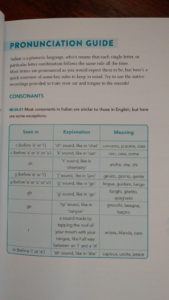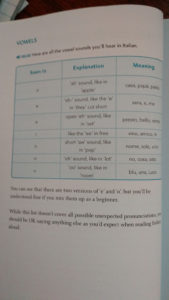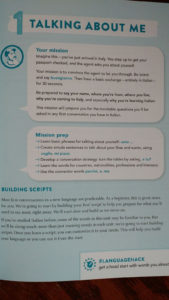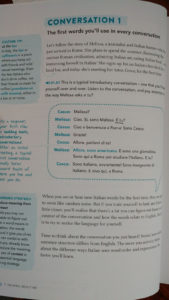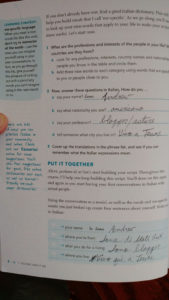 This is to be a general review of the whole Teach Yourself Language Hacking course authored by Benny Lewis. Though the one I tried was the Italian course, they’re all structured pretty much the same and utilize the same method, so a review for one will cover the rest as well. In other words, regardless of which one you’re interested in (there are four at the moment: Spanish, French, German, and Italian), this review is for you.
This is to be a general review of the whole Teach Yourself Language Hacking course authored by Benny Lewis. Though the one I tried was the Italian course, they’re all structured pretty much the same and utilize the same method, so a review for one will cover the rest as well. In other words, regardless of which one you’re interested in (there are four at the moment: Spanish, French, German, and Italian), this review is for you.
I chose the Italian version of the course because that’s the only language I didn’t have any experience with whatsoever and I wanted you to be able to get the perspective of a complete beginner, especially since that’s who it’s intended for. That brings me to my next point: let’s cover what this course purports to do and what it doesn’t, what it’s objectives are and aren’t.
What is this course, and what is it not?
Neither this course nor the author claim or imply that they will make you “fluent”, let alone in any specific amount of time (e.g. three months). I say this because a common, and very unfair in my opinion, criticism of Benny and his products is that they “claim to make you fluent in three months” (they don’t), or that they imply they will (no). The name of his blog is, yes, Fluent in 3 Months. He has explained repeatedly that this is because of how long his language-learning missions tend to last (about three months) and that he usually achieves fluency, per his definition of the word (which I think is quite reasonable) and that definition roughly corresponds to the B2 level per CEFR or what I and many people call “conversational fluency”. It takes him, someone who’s spending 8-12 hours a day (because he does this full time, his job is to learn languages and then write about it), three months to achieve this level in most languages. That doesn’t mean you can in 30 minutes a day 3 times a week or something – come on.
So what does it do?
This course teaches you two things:
- Conversational [Spanish/Italian/French/German]. This is a “conversation course”, as it’s called several times in the book (including the front cover), meaning that you learn from Italian conversations (they’re the heart of the course) in order to be able to make Italian conversation yourself. You learn how to “talk normally”, how to conduct common, everyday speech. Nothing too difficult, profound, obscure, or technical – just everyday conversation about common topics.
- Language hacking. Benny teaches you how he goes about learning a language and all his little tricks and “hacks”. He demonstrates many of them for you by actually having you apply them to the language in question. From the first page of the introduction: “It’s [language hacking] simply about being smart with how you learn: learning what’s indispensable, skipping what’s not, and using what you’ve learned to have real conversations in Italian right away.”
The whole objective of the book is to get you speaking as soon as possible, per his mantra of “speak from day 1”. I generally agree with this: there’s no good reason not to do it, and speaking has several benefits including helping you better remember what you’re learning (far better than if you just read or listened to it) and working on your pronunciation, plus the only way to learn how to speak a language is, as I like to say, to do so, badly at first. This is really intended to be something to give you just enough of the language to be able to start having conversations with people in it via language exchanges or in the country where it’s spoken, from which point you would then really accelerate your acquisition of the language. This is a kick-starter, a method of getting you launched, giving you enough momentum for you to then be able to carry yourself and keep going on your own by continuously speaking to natives in the language (which will do more to help you learn it than anything else you could do).
So let’s dive in. Let me explain how I’m going to do this: I’m just going to have you come along with me as I go through the very first chapter (what are called “units”) in this book. I actually recorded everything I did as I did it, meaning that from the very start of the lesson the camera was rolling and I recorded every last minute that I spent working on Unit 1. Now, obviously, I’m not going to expect you to sit through all of that (it would be 2-3 hours worth of video), so I’ve just taken some highlights for each section and included them below.
Introduction
The only thing I’m including from the introduction is the pronunciation guide because that’s the only part of it that actually has you learning Italian. This was just a short guide to the pronunciation of Italian, describing how the written language corresponds to the spoken language (what you see is what you get, Italian is a phonetic language just like Spanish), and how to pronounce the vowels and consonants.
Here are the two pages in question, and then a short video of me using it and listening to and repeating after the audio as instructed:
Unit 1: Talking About Me
Each unit (chapter) has a “mission” around which it’s centered, the mission is what you’re going to have to do at the end of the chapter, the dialogue you’re supposed to make a video of you saying and then upload to the Teach Yourself Language Hacking site, where other people are supposed to help you by correcting your mistakes.
In this case, the mission is to make it through Italian customs. Specifically, you’re to tell the customs officer your name, where you’re from, where you live, why you’re coming to Italy, and why you’re learning Italian. (note: click to images below to see a larger version, every page from Unit 1 follows)
He emphasizes building scripts, which I strongly agree with for beginners, particularly those who have never learned a language before and are therefore bound to be a bit nervous and self-conscious the first few times they use their new language to actually communicate with another person. In this case, he’s helping you build a script for what is probably the most common topics of conversation you’ll encounter when you go to a country where your target language is spoken (why are you learning [Spanish/French/Italian/German]? where are you from? etc.). Let’s have a look at that first conversation:
Conversation 1
Melissa: “Ciao. Sì, sono Melissa. E tu?”
Cesco: “Ciao e benvenuta a Roma! Sono Cesco.”
Melissa: “Grazie!”
Cesco: “Allora, parlami di te!”
Melissa: “Allora, sono americana. E sono una giornalista. Sono qui a Roma per studiare l’italiano. E tu?”
Cesco: Sono italiano, ovviamente! Sono insegnante di italiano. E vivo qui, a Roma.”
Ok. There’s the conversation, now what are we to do with it? Well first of all, read it and make the most of it you can, that is: say it out loud and, based on the pronunciation guide, try to pronounce it as close to correct as you can, and also try to discern what it means. Then, play the audio. I’d also like to note that, as you can see if you look at the image of the page above, there are several nifty little aside bonuses, e.g. the “Culture Tip” that describes Italian bars and how people socialize at them – I like that. Here’s a video of me doing the first conversation:
The Exercises
He’s included quite a wide variety of exercises based on the conversation, all of which require participation by the student and force you to learn via making mistakes, that is you have to do the best you can, then find out if you got it right. Very effective at getting you to remember the material (you’re much more likely to remember what you got wrong, and even what you got right if you didn’t know you were right when you said/wrote it). Oh, and yes, there is an answer key in the back for all of the exercises that require writing and have predictable answers (ones where you make up stuff particular to you obviously don’t have stock answers).
All of the say units will then have at least one of the following, though not all of these may be present for every single conversation (as such, some of the exercises below were based on Conversations 2 or 3 of Unit 1 but regardless you should be able to follow along and understand what’s happening and the point of it pretty easily):
Figure It Out
Next comes the “Figure It Out” exercise, which I particularly like because it forces you to guess and make mistakes. You’re supposed to fill in the blanks to simple questions asking you about what was said during the conversation and you’re to simply take your best shot at them, your best guess. Being wrong is encouraged (you learn from that!).
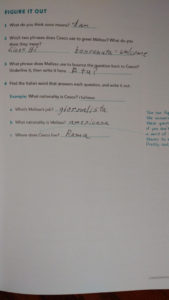 Here’s a short (~5min) video of me doing the exercise:
Here’s a short (~5min) video of me doing the exercise:
Notice
After this is a short review-and-confirm type of exercise, as I’ll call it, where you review the important words and phrases used in the conversation and confirm that they mean what you thought they did (no, you’re not just left to wonder if you were right forever). You’ll get a table of the relevant vocabulary – target language (Italian in my case) on the left and English on the right – and then a short set of exercises immediately after that will ask you how to say certain phrases in the language that you should be able to deduce from what you just learned, e.g. in the table above it says that “sono Melissa” means “I’m Melissa” and then one of the questions in the exercise below is, “How do you say the following in Italian…a) I am _______”. Well, if “sono Melissa” means “I’m Melissa”, then obviously “sono” means “I am”. You’re not just handed the answers in the table above – nearly so but not quite – you have to deduce them, and I like that…makes you work.
Pronunciation
After the “Notice” exercise will come either a “Grammar Explanation” or “Pronunciation” explanation and exercise, sometimes both. In these he simply explains some very limited (they’re always short so as to not overwhelm you) aspect of the pronunciation or grammar of your target language that was just used in the preceding conversation (so it’s always immediately relevant stuff). In this case we have a pronunciation explanation of “i” and “u” in Italian accompanied by an audio file and then a practice exercise with its own audio file:
 Here’s me doing the pronunciation section and its practice exercise:
Here’s me doing the pronunciation section and its practice exercise:
After that he emphasizes the importance of having a good dictionary for your target language so that you can learn to say whatever it is you what to be able to say (he calls this building “me-specific” vocab, which I agree with – stuff that’s personal to you is far more interesting and memorable). Then he has you do a couple exercises that force you to look up words because they haven’t been provided yet (e.g. I had to look up how to say “author” in Italian, which is “autore”):
Put It Together
Here he has you put together (hence the name) everything you’ve learned til now to build your “script”, that is what you’ll need to be able to say to complete the final mission at the end of the unit (chapter). In this case you have to say your name, where you’re from, what you do for a living, and where you live. See the bottom part of the above image for this.
Language Hacks
These are essentially valuable short-cuts he’s found that work for the language in question or languages in general, e.g.
- Use of cognates (p10). Italian, Spanish, French, and German all have thousands of words that are similar or identical to the same words in English, such as “pilota” (pilot) or “associazione” (association) in Italian, and he doesn’t just tell you this but also gives you rules for finding them, such as words ending in ‘-tion’ in English will frequently be cognates in Italian that end in ‘-zione’, such as “associazione” or “opzione”.
- Mnemonics and memory tricks in general (p28), e.g. basic association techniques such as thinking of the Beetle’s song Lucy in the Sky with Diamonds to remember that “la luce” means “light” in Italian.
- Sounding more fluent with conversation connectors (p130), e.g. “francamente” (frankly speaking), “anche se” (even if), “se ho capito bene” (if I understand correctly).
After each of these will be an exercise where he has you use the hack. Here’s the one from Unit 1 that teaches you to use cognates in order to quickly expand your vocabulary:
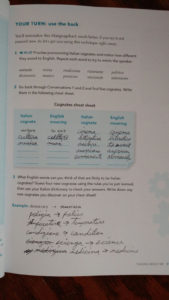 And here’s a short video of me learning the hack and then doing the exercise:
And here’s a short video of me learning the hack and then doing the exercise:
Grammar Explanations
These are short, only-absolutely-essential explanations of basic grammar. He’s really tried very hard to keep the formal, traditionally “boring” grammar lessons out of this course, but inevitably you must teach some. Some examples include:
- If a word (singular) ends in -o or -e, the last vowel changes to -i in the plural, e.g. “un giorno” (one day) becomes “due giorni” (two days).
- What the command form (imperative) is, how to use it, and how to conjugate verbs into it.
- Forming the past tense, in this case (p139) by using the easiest to learn method where he just teaches the student to say the conjugated version of “avere” (to have) plus the past participle, e.g. “I finished” = “Ha finito” (literally “I have finished”).
Here’s one from Unit 1 that I did where he teaches the simple (and very useful) “verb + noun” sentence structure:
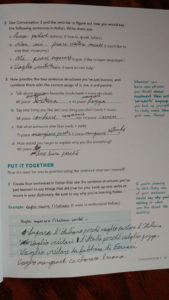 And here’s a video of me doing it:
And here’s a video of me doing it:
Conversation Strategy
Here he gives you basic strategies you can use in real-life spoken conversations, such as:
- Smoothing out your sentences with connector words like “and”, “or”, and “because”.
- Important “survival phrases” like “How do you say…?”, “Slower please”, “I’m sorry”, “I don’t understand”, “Can you repeat that?”, “One moment”, and “I can’t hear you.” For what it’s worth, this, in my opinion, is really valuable – you need to know how to say these things (you’ll use them a lot).
- Learn set phrases for each stage of the conversation, e.g. “Quanto tempo!” (it’s been a while) for the beginning, “Ultimamente sono stato…” (lately I’ve been) to help lead the conversation, and “E come lo trovi?” (and how have you found it?) to extend it further.
Here’s one I did from Unit 1 where I had to learn how to use connector words properly:
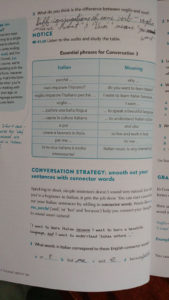
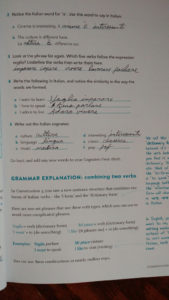 And here’s a video of me doing it:
And here’s a video of me doing it:
The Mission (end)
Finally, at the end of each unit, after you’ve done three conversations and all their accompanying exercises (covered above), you’ll have a “mission” to complete where you’ll have to actually used what you’ve learned to create a video that you’ll then upload to the Teach Yourself Language Hacking site where, hopefully, other people will evaluate it and help you. My mission at the end of Unit 1 was, as stated at the beginning, to get through Italian customs by:
- say your name and occupation using “sono”
- say where you’re from and where you live using “sono” and “vivo”
- say why you’re visiting Italy using “perché”/”mi piace”/”adoro”
- say why you’re learning Italian with “voglio imparare…perché…”
- use connector words along the way to sound a bit more fluent!
- Write down your script, then repeat it until you feel confident
After having made and memorized your script, you make a video of you speaking it. I opted not to look up anything I wasn’t sure about so that I ran the risk of making some mistakes and gave people something to correct in my video. Here’s my video of me completing the mission:
Lastly he encourages you to speak to other people in the language hacking community by viewing their videos and asking at least three follow-up questions (based on what they said) in Italian.
My Evaluation
I think overall this is an excellent (especially for the price: ~$20US) introductory course for beginners whose priority is speaking the language in normal conversation. The free audio (all of which use native speakers) is a massive bonus that really makes a huge difference in how useful this book is – without the audio it’s a supplementary course at best, with it it’s an entire introductory speaking course by itself. The wide variety of exercises (and the fact that all of them require the student to apply what they’ve just learned in many different ways) means that you never really get too bogged down in one particular thing (vocab or grammar or language hacks or whatever) and are always moving on to new things to do after a relatively short time. You can tell he’s really tried to make this as personal for the student (“me-too” language you create yourself) and interesting (lots of cultural notes about the countries the language is spoken in) as possible.
I have one definite criticism, and it’s actually of the audio of all things: they don’t give you enough time to repeat after the speaker, you end up having to pause it after each sentence in order to do so. It would be a dawdle to just insert a few extra seconds of blank space after each phrase/sentence by the native speaker where the student can repeat after them. It was easy for me to just hit the space bar and pause it while doing the audio at my computer, but for somebody listening to it in their car or on their phone while walking it might not be quite so easy. Also, in the audio, I would continually remind the student to repeat after the native speaker (that is so important) for maybe…the first half-dozen tracks or so, just to make sure they get in the habit of doing it. Lastly, I’d consider having the native speakers follow this format:
- Say the sentence at full speed, normally.
- Repeat it again slowly (maybe 1/2 speed).
- If there are any particularly tricky words you know native English speakers are likely to have trouble with, have the native speaker repeat them even more slowly, syllable by syllable, then again quickly a couple of times (with space after each instance for the student to repeat after them).
In other words: just go listen to something by Pimsleur and then do that. I’m spoiled by Pimsleur, no other audio course has come close to doing it as well as they do.
I should say, to be fair, this is a really minor complaint, more of a suggested adjustment, considering that the course is twenty bucks and the audio is entirely free (Pimselur is ~$250 per level, and there are typically four levels per language). But I feel like I have to pick on something, so there you go.
In summary, if you’re someone who’s more interested in learning how to speak the language conversationally than anything else (this is 80% of language learners), and especially taking price into account, I’d give this a 9/10. It’s a great beginner’s introductory speaking course.
Cheers,
Andrew

